A Black Agenda for New York City
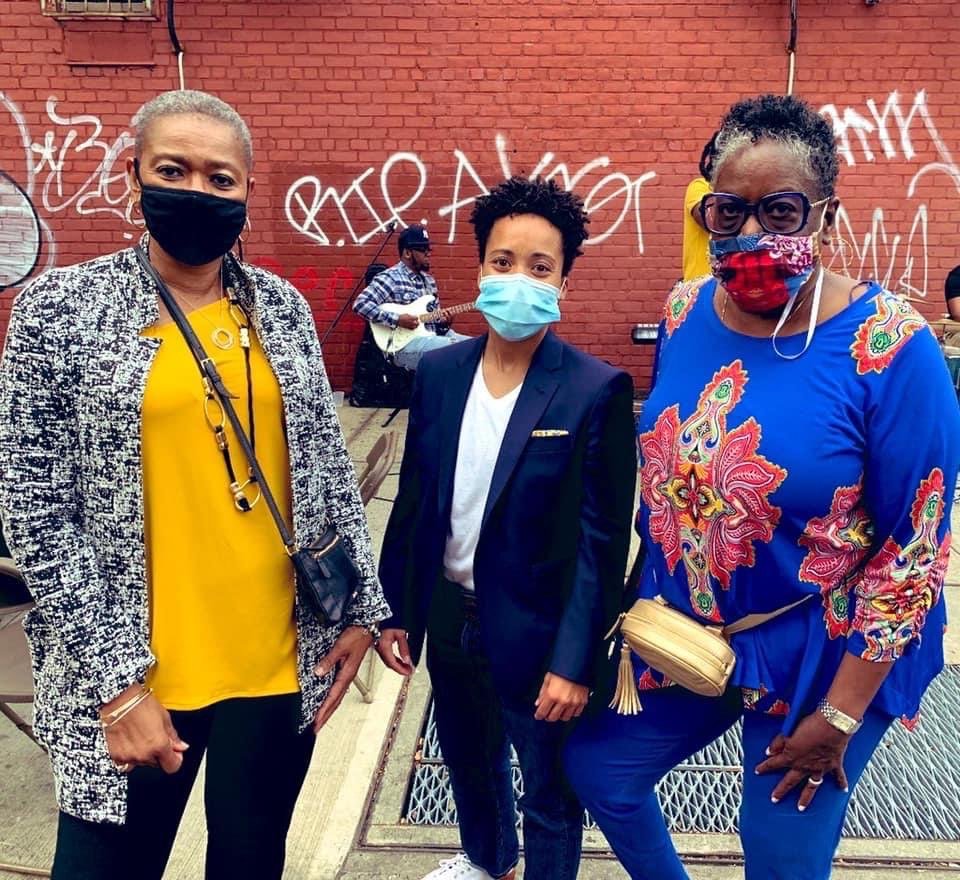
Crystal Hudson, middle, with voters (photo: Crystal Hudson campaign)
We’re nearing the end of Black History Month — a month of celebrating and honoring the Black people who have enriched and advanced our city. From Audre Lorde to Shirley Chisolm, we have no shortage of artists, entrepreneurs, and trailblazers to celebrate.
We’re also nearing the end of another February in America. A month in which we continue to see Black people die at the hands of the police at alarming rates. A month in which we continue to face a pandemic that is killing Black people at twice the rate of other Americans. A month in which our city’s vaccine roll-out continues to leave behind Black people who have experienced a disproportionate amount of loss from this crisis.
As we close out this month, we have to ask: how is our city actually supporting and protecting Black New Yorkers?
This is a conversation for every month.
To truly uplift Black New Yorkers, we need to advance a forward-thinking, explicitly anti-racist and pro-Black vision for our city’s future. We have to acknowledge our history and take specific and intentional action to right the wrongs of the past and the disparities of the present. We need A Black Agenda for New York City.
When Black New Yorkers thrive, all New Yorkers thrive. This means a guarantee of safety, housing, access to quality jobs, and the ability to raise families without the constant surveillance of law enforcement or the child welfare system. However, all too often our inability to zero in on the specific issues impacting Black New Yorkers means our solutions to structural and institutional racism are deeply insufficient.
I’m proposing a comprehensive plan to upend the injustices facing Black New Yorkers, starting with six urgent recommendations that speak to the gravity of this moment.
First, we must put money directly in the hands of Black New Yorkers with baby bonds and a paycheck guarantee so our city can set Black families up for long-term financial stability while addressing the ills of the past. We must create a pipeline for sustainable, unionized non-law enforcement jobs for Black New Yorkers to form a reliable pathway to the middle class and promote wealth-building. We must also build Black generational wealth and prevent displacement by encouraging community homeownership.
To address the disastrous impact of gun violence on our communities, New York City must pilot a basic income program in zip codes with the highest rates of gun violence so families can secure housing, put food on the table, and reduce the anxiety associated with being unable to afford daily necessities — factors that so frequently lead to violence and cycles of trauma.
Ultimately, to move forward, we must acknowledge the harm of the past; the city must launch a citywide truth and reconciliation process focused on race and reparations and create a racial equity commission to ensure every new policy and piece of legislation is written and enacted in an anti-racist manner. From the ills of the racist and misguided War on Drugs and widely practiced policies like stop-and-frisk to the surveillance and removal of Black children from Black parents and families, our city’s own government has committed undue harm to Black New Yorkers.
As a Black queer woman and candidate for New York City Council, I look to represent a district that has had to bear the pain of gentrification and displacement of Black residents, the overwhelming burden of rapid development that was never intended for us, the destruction of a healthcare infrastructure, and the erosion of businesses that can no longer afford to stay in our neighborhoods.
But my community, where my family has lived for three generations, is also home to so much of what makes Black New York remarkable: Soul Summit in Fort Greene Park, Black-owned retail and restaurants along Fulton Street, Dance Africa at BAM, Afropunk at Commodore Barry Park, the Caribbean diaspora in full display on Utica Avenue, the West Indian Day Parade along Eastern Parkway, and so much more. I’m fighting to protect the Black New Yorkers of today — the artists and entrepreneurs, the nurses and frontline workers, the unhoused and the vulnerable. But I can’t do it alone.
It’s time for New York City to show up for us and ensure that Black New Yorkers can thrive across all five boroughs.
***
Crystal Hudson is a Democratic candidate for City Council in Brooklyn’s 35th Council District. On Twitter @crystalrhudson.
***
Have an op-ed idea or submission for Gotham Gazette? Email This email address is being protected from spambots. You need JavaScript enabled to view it.
A Tale of Two Indigenous Monuments in New York

(photo: Matt Ballard)
The New York State Department of Transportation (NYS DOT) recently began installing engraved murals of New York’s Native American history on the Capital Region’s Northway. A few days later, the same NYS DOT threatened to demolish the Shinnecock Nation’s billboard monument on Sunrise Highway in eastern Long Island by issuing stop work orders, fines of $2,000 per day, and claiming it would forcibly remove the monument in 30 days.
Why is the NYS DOT creating a highway monument to honor Native American heritage in upstate New York and fighting ferociously to destroy a Native American highway monument in eastern Long Island? As the young people say: make it make sense.
Whether hoisted up or torn down, historical monuments are proxies of political power. Each carries its own negative with it: what else could/ should be here? What else was here? A highway monument honoring indigenous communities is denigrated as anathema or praised as progress depending on how it casts and shifts power; these are the tensions of our unreconciled settler history.
The billboard monument on Sunrise Highway is a source of revenue for the Shinnecock Nation, a federally-recognized Native American tribe struggling to provide for its people in the bastion of wealth that is the Hamptons. The revenue from the billboards will be used for child care services, food security, reproductive health access, dental care, and other urgent needs, and will be a foundation for future economic development projects. Beyond aesthetics, this monument furthers the Shinnecock Nation’s ability to survive and thrive on their land.
The engraved mural on the Albany highway has little economic benefit for the communities it is supposed to honor, the Stockbridge-Munsee, St. Regis Mohawk, and Delaware tribes. The native dancers are a concession, a compromise meant to smooth over the NYS DOT’s determination to build on a sacred site. The DOT promised to “include the aesthetic treatment [to] reference the Native-American heritage and culture…” after learning that the site for the proposed flyover was ancient, and sacred. The image of native dancers petrified in rock unlocks the space for thousands of cars to whizz by on a new flyover. If there are potential benefits for the indigenous communities, they lie in the realm of representation and spirit; the material benefits flow directly to the State of New York.
On Long Island, the billboard monument trumpets the Shinnecock Nation’s continued presence within the place known as the Hamptons. The violent settler narrative of the “vanishing Indian” is no match for the 20-foot billboards and the twinkling lights offering one singular message: this is indigenous land.
This unapologetic assertion of Shinnecock presence has called down controversy on the monument since construction began in 2019. For some of the neighbors in the Town
of Southampton, this vision of indigenous survival and presence was a distasteful intrusion into their highly-priced dream of rural bucolia. Vacillating between concerns about aesthetics, to potential driver distraction, to the need to preserve the ‘character’ of the Hamptons, residents of Southampton claimed that their aesthetic preferences should be valued over the Shinnecock’s economic development agenda. But NIMBY hardly works when it is not actually your backyard!
The Shinnecock Nation builds the monument on its own sovereign land without the say-so of New York State. This is as it should be: this is a federally-recognized tribe with the right to utilize their land. A New York State Supreme Court judge affirmed the Shinnecock Nation’s sovereignty and land rights in a May 2020 ruling, calling the Shinnecock’s rights to the land “undisputed” and expressing doubt that New York State would be successful in refuting the Shinnecock Nation’s claim of sovereignty.
If the Shinnecock billboard monument is a vision of future-facing indigenous sovereignty, the Albany mural’s origin story has troubling echoes of the past. The engraved dancers were a condition of the NYS DOT’s construction, but when the new flyover opened at the end of 2019 the mural was not installed; the DOT attempted to break even this modest promise about the erection and placement of these murals. After being prodded and cajoled into keeping its word, the state finally began installing the Capital Region murals in January 2021. The Northway’s monument tells an old story, a weary narrative about the slipperiness of New York State’s tongue toward indigenous communities echoes again.
How to reconcile the different reception of these two indigenous monuments, one built by New York State, the other threatened by New York State?
The Capital Region mural requires little of the state government and the non-indigenous neighbors. The engraved dancers are an aesthetic supplement furthering the priorities of the Albany government; they do not displace the status quo bequeathed by the settler past. Alternatively, the Shinnecock billboard monument is a vision of indigenous sovereignty come to life and bathed in neon light. Created and designed by the Shinnecock Nation, it directs wealth to the Shinnecock, alone. Trumpeting the vibrancy of a community rowing hard toward continued survival, the billboard monument sends an unmistakable message of permanence and power.
Now framing the highway that cut through Shinnecock territory in 1959, the billboard monument makes it clear that the indigenous future is not petrified in stone, to be gazed upon and consumed; it is dynamic, shifting, and expanding around us. This monument does not ask that we remember the Shinnecock Nation, but that we respect it, its members, and their rights, today and beyond.
***
Abena Ampofoa Asare is the author of Truth Without Reconciliation: A Human Rights History of Ghana; writes, researches, and teaches about historical justice and the African Diaspora; and is an Associate Professor of Africana Studies & History at Stony Brook University.
***
Have an op-ed idea or submission for Gotham Gazette? Email This email address is being protected from spambots. You need JavaScript enabled to view it.
Comprehensive Planning is Not Just About Housing and Zoning
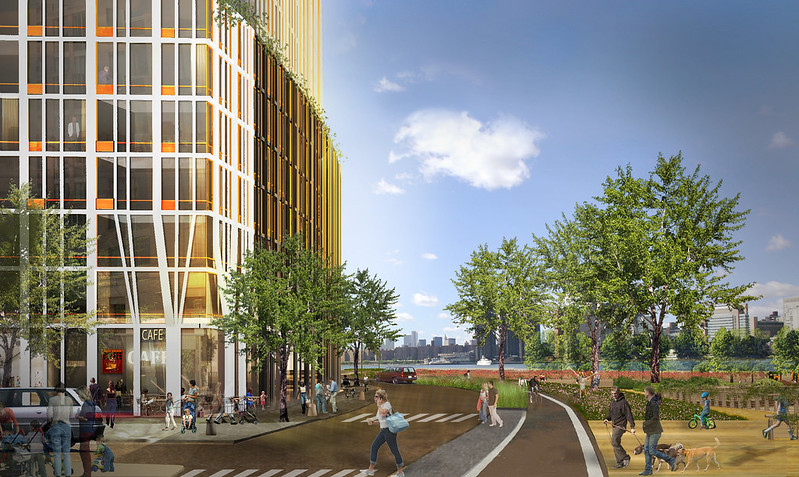
Rendering (photo: mayor's office)
The City Council held a hearing this week on a bill to implement comprehensive long-term planning in New York City. With the right amendments, we think this legislation has the potential to foster a more equitable and rational planning process to guide land-use changes in New York City — one that will balance local and citywide needs.
But comprehensive planning is about much more than land use. Done right, comprehensive planning touches on decisions in nearly all aspects of city life: education, transportation, public health and safety, sustainability, you name it.
One way to think about comprehensive planning is that it will finally provide a formal structure for city agencies to coordinate what they are doing and to stop the ill-informed, piecemeal decision-making that has led to unanticipated (but hardly unforeseeable) consequences.
Our organizations have seen this tragedy play out again and again. In 2003, for example, the City rezoned Fourth Avenue in Brooklyn with the inscrutable goal of creating a “canyon of housing.” The City pursued this narrow goal so myopically that it refused to seize obvious opportunities for preserving and creating affordable apartments--essentially extending and exacerbating the exclusive character of nearby Park Slope.
Over a decade-and-a-half later the community is still cleaning up the mess. The resulting influx of new, affluent residents immediately caused nearby schools to become not only severely overcrowded, but far more segregated as low-income children of color could no longer find seats there. One school had to reduce its attendance zone by half, one school had to be demolished and rebuilt with triple the former number of seats, and a third had to open anew. Although situated atop three subway lines, the tall new buildings included large underground garages belching out vehicles onto sidewalks; the pedestrian experience became intolerable. Lacking meaningful design guidelines, the resulting streetscape of blank walls and ventilation grates is some of the worst in the city.
Every one of these problems could have been anticipated and addressed through a formal process that provided meaningful opportunities for the community to engage in planning, required different city agencies to coordinate their long-term plans, and, most importantly, adhered to clear and immovable guiding principles such as racial justice, reduction of segregation in schools and neighborhoods, net creation of affordable housing, and prioritization of public transit and pedestrian safety and accessibility. This is what comprehensive planning promises.
Imagine if diverse government agencies and community members (given the proper resources) had been planning and thinking in advance — long before this rezoning process even started…
About how upgrades to public transportation and bicycle infrastructure could obviate the need for underground garages for luxury housing towers with comparatively excellent subway access?
About a plan to coordinate the creation of new market-rate and affordable housing with innovative student-assignment policies that would lead to more affordable housing in well-resourced areas of the city, racial and economic integration of the neighborhood and its schools, and more efficient use of existing school buildings?
About how to improve pedestrian safety and reduce traffic violence so parents can feel comfortable sending their children to the broad range of schools and parks within walking distance?
About the role of an individual action like the Fourth Avenue rezoning in advancing racial justice, equity, and integration across the city as a whole? And in shifting the benefits and burdens of city life, growth, and change equitably?
Is this a fantasy? Not at all. In fact, comprehensive planning is the norm for most municipalities of any size. New York City’s exceptional size, complexity, and competing needs only increase the necessity of a formal and predictable planning process.
The current legislation requires some amendments to enshrine better public transit, specifically faster buses, and integration as explicit goals; to give local communities a real opportunity to plan proactively without being allowed to override the public good of the city as a whole; and to ensure that the plan will actually guide official decision-making.
This is work worth doing. We can get this right, and the time is now to make it happen. We simply can’t tolerate any more of the status quo.
***
Danny Pearlstein is the Policy and Communications Director at the Riders Alliance. David Tipson is the Executive Director of New York Appleseed. Both organizations are members of the Thriving Communities Coalition. On Twitter @RidersAlliance, @AppleseedNY & @thrivingccnyc.
***
Have an op-ed idea or submission for Gotham Gazette? Email This email address is being protected from spambots. You need JavaScript enabled to view it.
What Schools Need to Reopen Safely and Truly Serve New York’s Kids
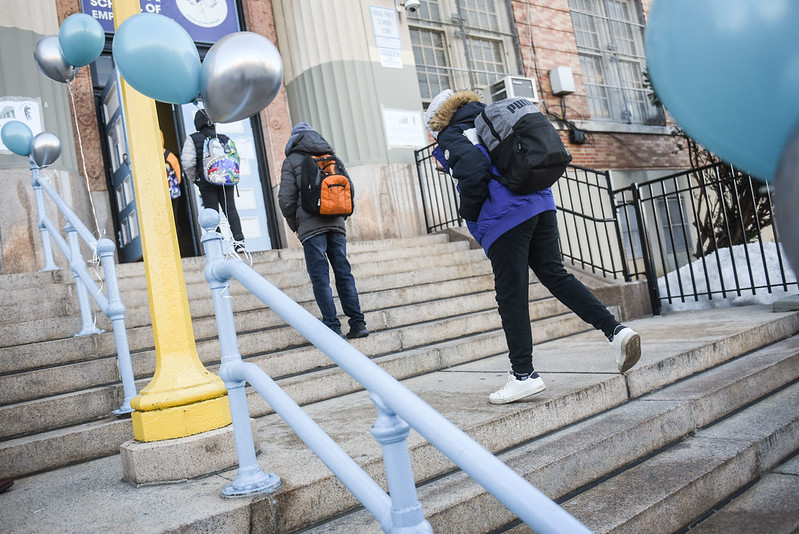
Kids back to school (photo: Michael Appleton/Mayor's Office)
On Thursday morning, February 25, thousands of New York's middle school students scrambled for misplaced backpacks and student MetroCards, trundled out the door, and made their way to long-abandoned classrooms, ready at last to resume in-person instruction after months of remote learning. Thousands of teachers were there to greet them—many no doubt wearing nervous but enthusiastic grins behind their doubled-up facemasks.
Sadly, my daughter Karina—a seventh-grader at Brooklyn's MS 88—wasn’t among them. That's not to say she's not eager to return. Like so many of her fellow students, Karina has struggled with remote learning. Like many parents, I've struggled along with her. We are badly bruised from this fight.
But much as our family has longed for a return to normalcy, we've been down this road before. Last fall, Mayor Bill de Blasio announced that schools would be reopening on Sept. 10, then the 21st, then the 29th. (Middle schoolers, who were offered a hybrid system, returned on Oct. 1.) The experiment lasted less than two months, at which point a positivity rate of more than 3 percent prompted another citywide shutdown.
Then came yet another about-face, as de Blasio abandoned the 3 percent threshold altogether. After all, the argument went, if restaurants are open, why aren't schools? Of course, that left unexamined the questionable decision to restore restaurant dining at all, given the surge in the virus. Are such judgments being driven by science, by economic pressures, or by the perpetual pissing match between Mayor de Blasio and Gov. Andrew Cuomo? No one knows for sure. What is certain, however, is that the funding necessary to allow schools to implement life-saving measures (upgraded ventilation systems; consistent, methodological and science-based testing of students and school workers; appropriate staffing of school nurses and counselors to deal with both illness and grief; and more) never materialized.
Unable to trust our elected officials, we did what seemingly every other family is doing: we read up on the latest research, talked to many friends and parents in the neighborhood, and gamed out the pros and cons for ourselves. We considered the recent CDC guidance suggesting schools could be made safe, along with the welcome decline in positivity rates. We weighed the pitfalls of remote learning (unreliable technology, Zoom fatigue, and Karina's wildly erratic grades and growing disinterest in school) against the risks posed by new strains of the virus and chaotic decision-making by elected officials.
We talked to our girls about how they felt about returning, both expressed ambivalence appropriate for their age, but also real concern about safety and a recognition that there are not enough resources for everyone. They know there are other kids and families that absolutely need in-person learning and we should focus our limited resources on making sure they are all safe. Having lost four of our family members to the virus — two in nursing homes, and two in their houses — we know thousands of other students and educators are also still navigating unprocessed grief and trauma. Given all this, we decided against sending them back to school. We opted to play it safe.
That said, as a former PTA president and member of MS 88's school leadership team, I'm well aware that not every family has the privilege to make this decision. I recently spoke to one Red Hook mom whose five children are all learning remotely, or trying to. Due to the lack of other child care options, this mom had been unable to work for months, with the expected impact on the family finances. Meanwhile, she's had to step in as impromptu technician, substitute teacher, lunch lady, and child therapist for her kids, two of whom — both with special needs — recently received "promotion in doubt" letters indicating they may be held back. It’s been agonizing to watch how frustrating remote learning has been for the kids and how far behind they have fallen. No one seems to be seriously concerned about their socio-emotional needs. For this mom, a return to classroom learning can't come soon enough, but she still views the plan as incoherent and fears for her children’s safety.
The decision is no less agonizing for teachers. Despite the outrage they have faced from frustrated parents and politicians — who often seem more interested in demonizing teachers' unions than vaccinating their members — most want to be in the classroom. But they don't want to risk their lives, or the lives of their loved ones or neighbors to do it. And many know all too well that the same lack of funding that has for years forced them to pay out of their 0wn pockets for much-needed supplies is making it impossible for administrators to keep classrooms safe. After all, hundreds of city schools have already been forced to close due to covid cases — hardly a reassuring sign.
The battles breaking out between families and teachers around the country — often in wealthier school districts — are heartbreaking, particularly when you consider the children stuck in the middle, watching in bewilderment as adults engage in a schoolyard brawl.
Instead of blaming one another for a global tragedy that none of us asked for, I'd like to see us work together to examine how the system itself has failed and to fix it. At the heart of that failure is something we all understand: money. The decades-long underfunding of our school system has always represented a crisis for residents of certain zip codes, but it was a crisis that New Yorkers of means willfully overlooked. The pandemic spread the pain around. It exposed a system held together with Elmer's glue and popsicle sticks, along with the heroic efforts of dedicated teachers, administrators, parents and kids, who do their best every day to make it work, whatever happens in Albany and in City Hall.
According to the Alliance for Quality Education, even before the pandemic swept through the state, New York was ranked 49th in the nation in terms of educational equity. The organization further notes that “8 out of 10 Black and Latinx students attend a school that has been systematically underfunded by the state.” Meanwhile, police and prisons are showered with resources, prompting tens of thousands of New Yorkers to take to the streets to demand change.
The pandemic highlighted the dire consequences of this neglect. But if you thought the crisis would be an opportunity for our elected officials to address the situation, for instance by increasing taxes on the wealthiest New Yorkers, you may be disappointed. In fact, the opposite is happening. Last year, when the federal government sent the state more than $700 million in relief funds to help schools absorb costs related to the pandemic, Gov. Cuomo actually shifted the same amount of money out of the state education budget. Worse, according to an analysis by Chalkbeat and the American Institutes for Research, such fiscal shenanigans left schools in high-poverty areas shouldering more of the burden. Overall, New York City's schools received $200 less per student, even with the federal help, than they would have under the approved state budget, a disappointing violation of Cuomo's bold pledge to finally "close the education gap." His recently released budget proposal for fiscal year 2022 pulls similar tricks, advancing several bait-and switch proposals that will cut an estimated $600 million more from what New York City public schools should have expected. We have every reason to believe the governor will continue to use federal funds earmarked for pandemic-related education expenses to close a budget shortfall.
The equity gap may well widen further as the state seeks to respond to its fiscal deficits not by asking the wealthy to finally shoulder their share of the burden—heaven forbid—but by instituting an austerity budget that will further gut our school system, punish school workers and short-change our kids. Meanwhile, the governor has been granted sweeping new power to make further cuts unilaterally (though the emergency authority may be revoked in light of the ongoing nursing-home scandal). Further cuts may well fall on both rich and poor districts. But as we learned following the 2008 economic meltdown, wealthier districts can always make up the difference by hiking property taxes, an option that's simply not feasible for New York City’s public school system, especially in high-poverty areas.
In the end, whether a given family opts for in-person instruction or sticks with remote learning is beside the point. For too many students, 2020 will go down as a lost year, not because their parents made the wrong choice or because teachers' unions sought to rightfully protect their members, but because New York once again balanced its budget on the backs of working people and let the wealthy off the hook. The problem, as any good teacher could tell you — whether on a screen or in person — comes down to basic arithmetic.
***
Alexa Avilés, a mother and organizer in Sunset Park, Brooklyn, is a candidate for the New York City Council in District 38. On Twitter @AlexaForCouncil.
***
Have an op-ed idea or submission for Gotham Gazette? Email This email address is being protected from spambots. You need JavaScript enabled to view it.
The Governor’s Budget Threat to New York’s Most Vulnerable
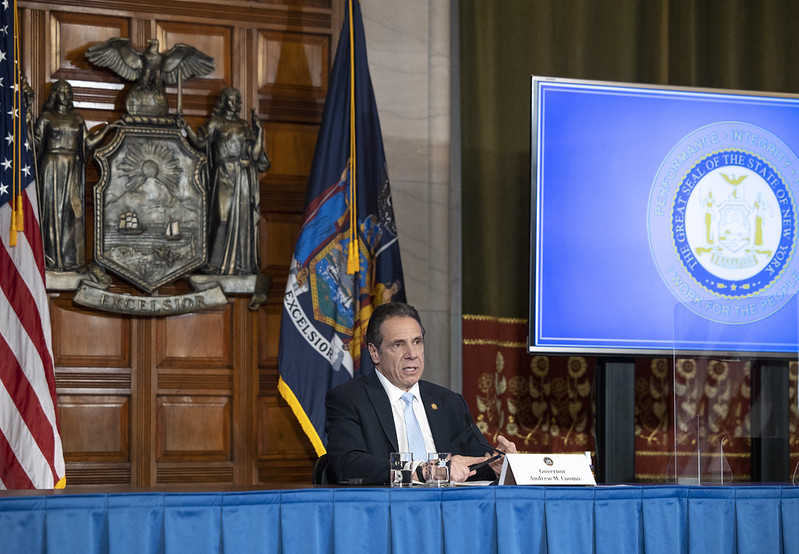
Gov. Cuomo (photo: Mike Groll/Governor's Office)
New York State is at a crossroads when it comes to caring for individuals with intellectual and/or developmental disabilities (I/DD). Government officials have a choice to continue divesting from the system leading to irreparable harm for our most vulnerable citizens or they can right the ship by maintaining the investment in the organizations providing support to the majority of individuals in the state with I/DD.
One such group of organizations is Care Coordinated Organization/Health Homes – entities created by the state in 2018 to provide critical and essential services to people with I/DD. Now, less than three years later, these essential organizations are facing another 23% cut in Governor Cuomo’s Executive Budget plan, which, if enacted, would total almost 40% cut over a period of just over a year. If this cut moves forward, it would result in the dismantling of care coordination and advocacy for 110,000 people with intellectual and/or developmental disabilities.
Many New Yorkers with intellectual and/or developmental disabilities need help accessing basic human needs – food, housing, medicine, employment, community resources, and transportation. We partner with these individuals and their families to help them through life’s challenges.
Many people with I/DD have incredibly complex medical, behavioral, and social needs that require high-quality, specialized care. This is where Care Coordinated Organization/Health Homes come in and play a key role. We provide support ranging from navigating and coordinating medical and behavioral health services, and long-term care services.
Cutting Care Coordinated Organization/Health Homes funding will lead to increased and preventable hospitalizations, institutionalization, and homelessness. It is unconscionable to implement a cut to services to a population that face up to five times greater risk of dying from COVID-19 due to their comorbidities and chronic health conditions.
The fact is, the New York State Office for People with Developmental Disabilities is not keeping the promise that Governor Cuomo made a decade ago when he promised “care management for all.” Not only did it take seven years for the Care Coordinated Organization program to be developed, now the state is preparing a knock-out blow by obliterating our funding. The dissonance in the state’s messaging versus its actions from the Office for People with Developmental Disabilities’ hidden funding reduction action is especially dangerous at the height of an unprecedented pandemic.
As Care Coordinated Organization/Health Homes for individuals with intellectual and/or developmental disabilities we are more than just care coordinators. We’re advocates. Oftentimes, we are the literal lifeline. Many New Yorkers with intellectual and/or developmental disabilities do not have family to care for them or are unable to advocate for themselves. Because of this, they're more likely to have their rights violated; lose access to benefits such as Medicaid and lose access to services and supports to meet their needs. They should not be left to navigate the complicated Office for People with Developmental Disabilities, public benefit, and health-care system bureaucracies on their own.
So, what can be done? We are not asking for additional funding, but begging the state to not gut the care coordination system that was promised long ago and so many now rely on. We are asking that Governor Cuomo correct this wrong by using a portion of the additional $2 billion in enhanced Federal Medicaid funding already committed to New York State by President Biden after the governor’s executive budget was released.
New York simply cannot ignore the vulnerable human beings in our care. Whether New York State tears up their safety net or not; they exist, they love, they hurt, and they need care and support now more than ever. We call on New York State to restore the funding and not to move forward with the proposed cuts to ensure the Care Coordinated Organization/Health Homes model of care is intact in order to deliver the critical care coordination and advocacy services that New Yorkers with intellectual and/or developmental disabilities deserve and have come to depend on.
***
Jim Moran is the CEO of Care Design New York.
***
Have an op-ed idea or submission for Gotham Gazette? Email This email address is being protected from spambots. You need JavaScript enabled to view it.
The First Step to Fixing Our Disregard for Women of Color in the Workplace
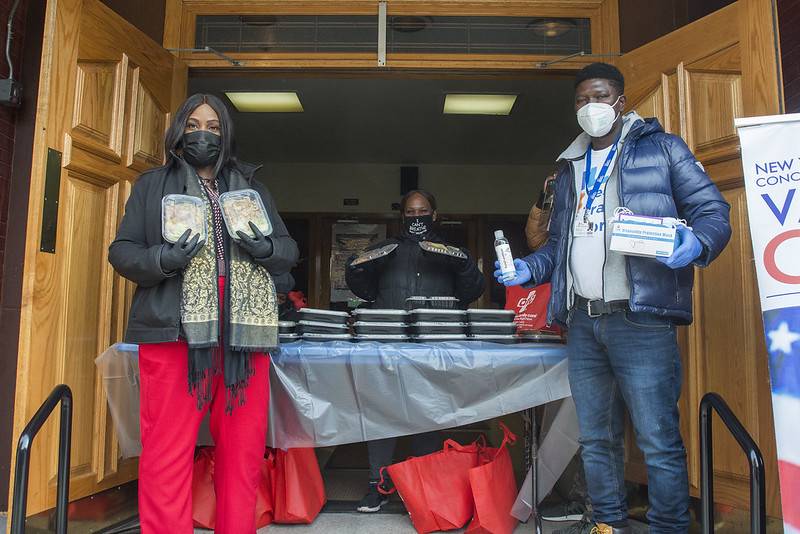
Council Member Vanessa Gibson, left, is a coauthor (photo: Jeff Reed/City Council)
The pandemic is setting women back and eroding years of progress, particularly for women of color in New York City. The pressure is coming from two places: women of color are more likely to work in sectors that have been hit hardest by layoffs, and women of color are more likely to have had to leave work or reduce hours to care for children during school closures.
This spring saw the highest unemployment rate for women on record, with Black and Latina women faring worst, and the damage is ongoing. According to the National Women’s Law Center, 100% of the jobs lost in December belonged to women.
This is a significant issue, and it highlights the need to ensure that our city is dedicating resources to a recovery that is equitable and centered on women of color. One simple way to start is with the wages we set for human services workers.
The nonprofit human services sector delivers programs on behalf of the city through government contracts, from youth services to senior services and everything in between. These organizations get as much as 90% of their budget from government contracts, which set the wages of their employees. That means the city is responsible for determining the wages of these workers, 82% of whom are women and 80% of whom are people of color. Despite the clear impact of their work, women of color are some of the lowest-paid workers in the economy. The average human services worker lives at or below the poverty line.
Let’s say that again: the city has determined that women of color who are the care-takers of our society deserve poverty-level wages. This was always insulting, but after the pandemic it is infuriating and wholly unacceptable.
Women of color showed up, risked their lives, and in some cases lost their lives during our darkest hour. They worked to ensure that seniors received meals when they couldn’t go outside, that children who lost loved ones received support, that survivors of domestic violence were able to find safety, and that those whose lives had been ripped apart received mental health care. They continue to shoulder our burdens today, and they will continue to be a critical part of our recovery.
As members of the Women’s Caucus of the New York City Council, we must demand that these organizations and their workers are protected from additional budget cuts. We are aware of the city’s dire financial situation, but we cannot close the gap on the backs of those who are already at their breaking point.
Years of chronic underfunding have left a brittle sector that can no longer make up for holes in government funding. A survey of 125 nonprofit human services organizations by the Human Services Council and the New York City Employment & Training Coalition showed that nearly two-thirds (64%) of organizations predicted program reductions and permanent shutdowns, and even more (70%) predicted staff layoffs, which would compound the city’s unemployment crisis.
Mayor Bill de Blasio has committed to protecting several labor unions from budget cuts, protecting their jobs through June. Black and brown women in the human services sector deserve the same protection. And as soon as it’s possible, these women should be first in line for a raise.
Human services workers have always been essential to the stability of our neighborhoods, and now the strength of our recovery will depend on this workforce. We will need programs to help students get back on track, job training for unemployed workers, and eviction prevention services.
The mayor has said for months that equity must be at the center of our COVID-19 response and recovery. We could not agree more. By supporting human services workers and the communities they serve, we can make that commitment a reality.
***
City Council Members Vanessa Gibson and Farah Louis represent parts of the Bronx and Brooklyn, respectively, and co-chair the City Council's Women's Caucus. On Twitter @vanessalgibson, @CMFarahLouis, and @WomensCaucusNYC.
***
Have an op-ed idea or submission for Gotham Gazette? Email This email address is being protected from spambots. You need JavaScript enabled to view it.
New York’s Next Shot to Strengthen Our Democracy
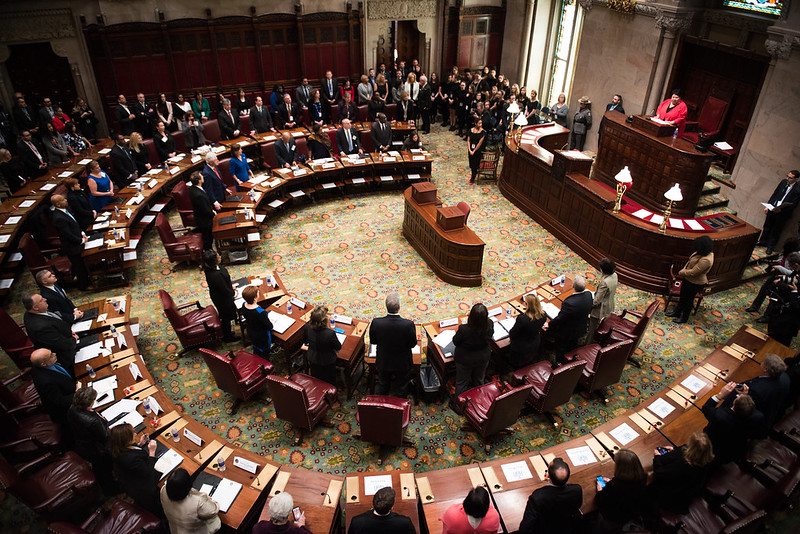
The State Senate chamber (photo: Edwin J. Torres/ Mayoral Photo Office)
American democracy is suffering a crisis of confidence. In too many states, the very mechanics of elections has become a partisan and polarizing issue, with deeply damaging results. This year New York has the chance to model a path forward, with a bipartisan commitment to strengthening democracy and providing the best possible systems for our citizens to be heard.
As appointees to the state’s new Public Campaign Finance Board, that commitment is our pledge. In 2020, the state enacted a new small donor public financing program, to amplify the voices of more New Yorkers in the political process. We were appointed to oversee this program by opposing party leaders in the Legislature. By choosing us, they knew they were choosing problem-solvers bent on working together. Whether longtime supporters of the policy or thoughtful critics, now that public financing is the law, our duty is to prepare the program for a successful launch in November 2022.
We know our fellow officials and staff at the New York State Board of Elections are ready to work together toward that launch, even with hardly a chance to catch their breath after the challenge of holding elections in a pandemic. We are grateful that Governor Cuomo’s proposed budget for next fiscal year includes the necessary start-up funds for the public financing program and we urge our elected leaders to maintain that commitment through the adopted budget.
This voluntary program will enable candidates for legislative or statewide office to try to qualify for public matching funds for small donations (under $250). Contributions by New York residents to statewide candidates will be matched $6-to-$1. Legislative candidates can be matched for donations from residents of their districts — the smaller the donation, the higher the match.
Getting this program off the ground requires an extensive administrative coordination, from hiring staff to procuring office space to working with vendors who can help build and test the relevant technology. As these resources get into place, staff will also be writing the rules and regulations that will govern the program.
Of utmost priority for us as commissioners is creating transparent public financing that’s worthy of the public’s trust. This means having clear guidelines that explain when a candidate is allowed to receive matching funds, and what happens when anyone violates the rules. And it’s also essential that the system is user-friendly so that candidates find it straightforward to take part, with the rules and regulations enforced equitably among all who participate. Doing both means the public is assured that their dollars are secure and new candidates inspired to run and veteran public servants alike can be confident they are treated fairly. We will reach out to experts who have successfully done this before, learning from them as the Public Campaign Finance Board moves forward in New York.
There is no time to waste: New York is required to launch small donor public financing by November 2022, so that candidates running in state elections in 2024 are able to fundraise under the new program. Connecticut’s simpler public financing program took two years to build. But if the program receives the necessary start-up funding this year, we are determined to work together and with our colleagues to make this program a success – and make New York an example for other states looking to bolster their democracies.
***
Ekow N. Yankah and Brian M. Kolb are members of New York state’s new Public Campaign Finance Board.
***
Have an op-ed idea or submission for Gotham Gazette? Email This email address is being protected from spambots. You need JavaScript enabled to view it.
For True Public Safety, We Must Fight Crime and Its Root Causes
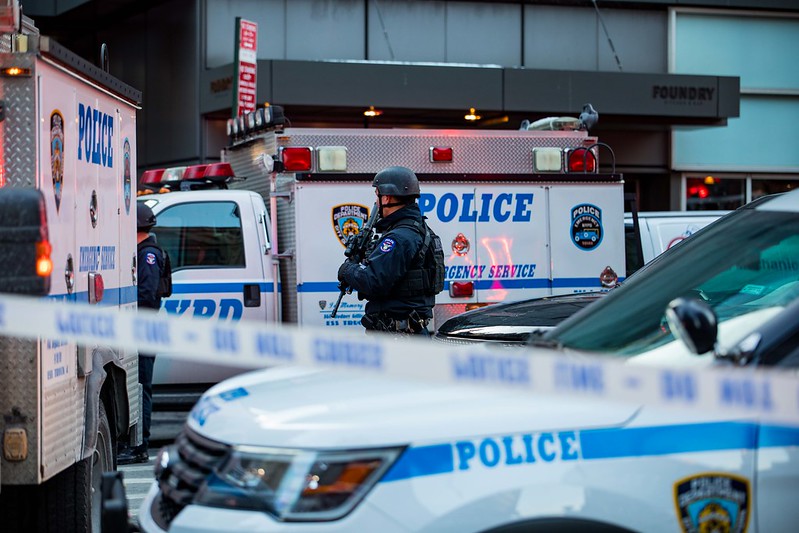
NYPD (photo: Benjamin Kanter/Mayoral Photo Office)
As a business leader, a Democratic candidate for mayor of New York City, and a Black man, I know what it means to have multiple identities. While I may be Mr. McGuire in the boardroom, every time I change into a sweatsuit to run or play basketball, I know that I’m first and foremost a six-foot-four, two-hundred-something-pound Black man.
I am also the father of an 8-year-old son who I fear one day could be the next Tamir or Trayvon. My wife Crystal and I have already given him “The Talk,” just as my mother once gave to me. No parent should have to uproot their own child’s innocence because we live in a world where young Black boys are misconstrued as dangerous. Far too quickly, our boys are forced into the responsibilities of men.
At the same time, our city is facing a disturbing surge in crime. Murders and shootings are up sharply. There’s a palpable sense of fear throughout the city. The NYPD is stretched thin by responding to mental health and substance abuse crises and a COVID-induced budget crisis amplified by a critical need for civil rights reforms. This tension approaches its snapping point every time a cop stops a potential suspect.
I know this tension well. When I’m stopped in the car outside my home, my hands go up just as I was taught. Our city needs a new approach to public safety, one based in a common understanding of that everyday struggle in communities of color. It’s a struggle to survive.
It’s not that Black and brown communities don’t want the police on their streets. On the contrary, it’s that they want the respectful, accountable, and proportionate service they deserve.
My approach to public safety is to not only reduce response times to solve actual crimes, but also to attack the root causes of disorder. It’s a sweeping approach to ensure every child has the support and resources they need. That’s why Gwen Carr, the mother of Eric Garner, endorsed me for mayor, saying, “You would know how to get things done.”
Our city faces a real spike in violent crime, largely due to interstate gun trafficking, and if combatting those threats is our police department’s number one priority, as I believe it should be, we must dedicate the resources and personnel to handle the task. The only way to do that is by re-focusing the role of police on what they’re best trained to do: fight crime.
Yet despite being under-trained to handle every problem that falls through the gaps in our social safety net, that's exactly the job they’ve been tasked with for decades.
If things had gone a little differently in my life, I might have fallen through those cracks as well. I was born on the other side of the tracks in Dayton, Ohio to a single mother who was a social worker. I never knew my father. At any one time, my two brothers and I might have a half-dozen foster kids living with us. For the kids, my mother was the safety net.
And yet with a loving community, teachers who supported and challenged me, hard work, and a little luck, I was given the chance to succeed where so many others are denied — making my way to Harvard, then to business and law school. It taught me that justice isn’t just about keeping crime down; it’s also about lifting people up.
Unfortunately, years of neglect have already failed too many of our neighbors.
Take the case of Rigoberto Lopez, who allegedly killed two people on the subway this week. Mr. Lopez has a history of being hospitalized for mental illness and also four prior arrests for drug possession, as well as violent crimes. As a result of his subway attacks, more than 500 police officers were deployed to patrol the subways last Saturday. That’s a 20% increase in police caused by one man.
It doesn’t take a finance executive like me to see that these numbers don’t add up. Under my plan, a person like Mr. Lopez would have received treatment and support to ensure that he did not become violent in the first place. Our goal must be to treat the individual, and not just respond to the incident.
Under my plan, during his first mental health crisis Mr. Lopez would have been met by Emergency Social Services, a 24/7 network of mental health, drug abuse, and homelessness specialists that will replace police intervention for non-criminal behavior. This would have freed the police unit that actually responded to continue to patrol their beat.
These expressly-trained responders would have taken Mr. Lopez to Bellevue to treat the acute crisis and, instead of releasing him back onto the streets to continue his downward spiral, would also follow-up and connect him with the long-term mental health and substance abuse services he required.
Allowing people to go untreated is not humane. It’s not justice. And it’s not safe. We absolutely need to have rigorous safeguards to protect civil rights, but we also need to be able to get people treatment before they harm themselves or others or find themselves caught up in the criminal justice system.
Lastly, beyond the budgets and metrics lies the truth for many New Yorkers: that the police are the day-to-day face of city government. Whether you live in an apartment on the Upper West Side, a NYCHA development, or are suffering from homelessness, you deserve to be treated with dignity and respect. Accomplishing this will require renewing the frayed social contract between the police and New Yorkers.
While our city gave me the opportunity to become Mr. McGuire in the business world, the tension that remains between law enforcement and people who look like me is palpable. All New Yorkers, no matter their zip code, deserve a policy of policing that looks at them and sees a person, not a threat. And that’s why I hope to be called “Mr. Mayor.”
***
Ray McGuire is a Democratic candidate for New York City Mayor. On Twitter @RayForMayor.
***
Have an op-ed idea or submission for Gotham Gazette? Email This email address is being protected from spambots. You need JavaScript enabled to view it.
The Oft-Ignored Real World Benefits of a Yeshiva Education
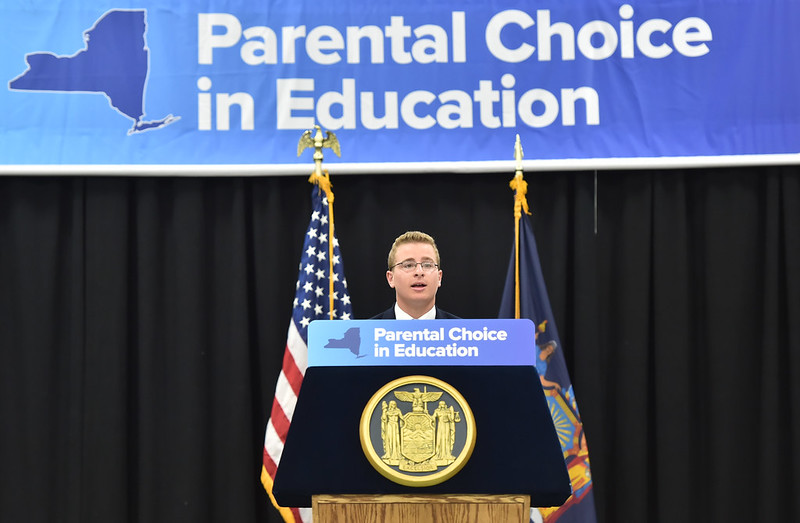
"Parental Choice in Education" (photo: Governor Cuomo's Office/Kevin P. Coughlin)
My career began with my yeshiva education; a rigorous study of the Talmud that sparked a relentless pursuit of reason.
There is a common misconception that religious studies are not as academically rigorous as secular education, but that is far from the truth. Yeshiva education fosters logic and logic fosters innovative problem-solving. Yeshiva education is, quite frankly, more beneficial to the development of students’ analytical skills than secular education because it demands critical thinking inside and beyond the classroom.
Yeshiva education promotes cognitive dissonance; a constant reckoning with what we think we believe and how we can gain even deeper understanding. For example, the three-dimensionality of the Jewish alphabet taught me how to look at the world in a new way. From the time I could read, the alphabet conditioned my mind to follow my own original courses of thought.
Like most students, I didn’t know where life would take me after I completed my education. But I knew that I would go into a field where I could think critically and pursue innovation. So, I turned to an industry that made the most sense to me: computer science. Thus began my career in software and business.
The logic mindset yeshiva education instilled in me has enabled me to thrive in the software space. I have the capacity to engage and probe in new ways, granting me the wherewithal to pursue industry needs from a distinct perspective.
When analyzing a computer system, one must think about how each piece of the system or program comes together like a puzzle. Like any puzzle, there are unexpected problems and unlimited approaches that one must adapt to in order to arrive at a solution. This is how I have approached my businesses, and it has contributed to their economic and societal successes and impacts.
My yeshiva education gave me another unparalleled advantage: wisdom. It taught me that everything is fluid and can be looked at from a number of perspectives, a teaching I follow every day and one that allowed me to found and build two companies I eventually sold to international conglomerates.
My first company that I built and sold was DPC (Data Publishing Company). I started DPC in 1994, selling sales tax compliance data and systems to numerous Fortune companies, and sold it to a multinational Dutch company six years later. My second company, Business Licenses, LLC, managed governmental business license compliance for industries and jurisdictions across the U.S. The company was so successful in the field that its licenses, permits, and tax registrations were acquired by a leading tax compliance software firm. Clearly, my religious education did not stymie my success as a business leader, nor does it hinder the economic and professional successes of yeshiva graduates everywhere.
Educational freedom prepared me —and my many fellow yeshiva graduates, at United Talmudical Academy (UTA) and beyond — to enter society as productive members with unique perspectives and life experiences adding to the kaleidoscope of the general population, making America exceptional. This diversity is a pillar of the American experience, something so cherished and irrefutable that suppression of our freedom to educate our children religiously is un-American.
***
David Polatseck is a lifelong Brooklyn resident, graduate of its yeshiva schools, and a businessman.
***
Have an op-ed idea or submission for Gotham Gazette? Email This email address is being protected from spambots. You need JavaScript enabled to view it.
Legalizing Marijuana the Right Way
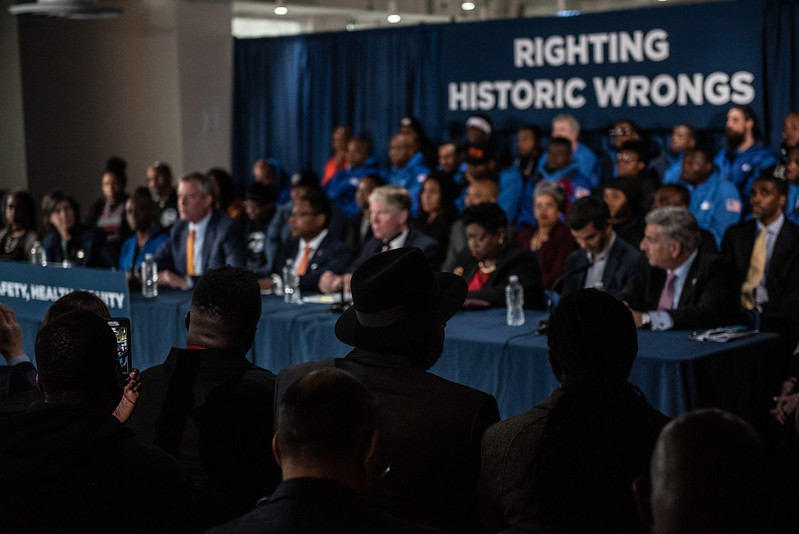
Mayor de Blasio, DA Vance & others discuss marijuana legalization (photo: Michael Appleton/Mayor's Office)
Because of the coronavirus crisis, New York is facing a massive budget hole and calls for innovative solutions to dig us out of this fiscal crisis. While Governor Cuomo recognizes the tremendous tax windfall that would come with the legalization of adult-use cannabis, this is about more than just tax revenue.
The reality is that New Yorkers will face a mounting racial and criminal justice crisis without a more equitable plan like State Senator Liz Krueger and Assembly Majority Leader Crystal Peoples-Stokes have put forward in their Marijuana Regulation and Tax Act. The governor’s plan offers less in terms of racial equity and some of his proposed penalties for cannabis-related offenses will only perpetuate the very problems that criminalization has caused.
Legalization must mean redirecting law enforcement resources to address more serious crimes, expunging records for millions of New Yorkers unfairly ensnared in the criminal justice system, and the creation of tens of thousands of new jobs. Cannabis licensing and sales can be utilized in a way that disrupts the cycles of marginalization, violence, intergenerational poverty, and trauma that have plagued communities of color for decades.
Unfortunately, these potential benefits quickly evaporate with the wrong policy. Any legalization plan needs to ensure that the communities that have been and continue to be disproportionately impacted by criminalization benefit from legalization through reinvestment, as well as opportunities to participate in the legal market. It should not further criminalize the use of cannabis, like the governor’s current proposal, which makes it a class A misdemeanor with no caveats to sell, exchange, or give an individual under the age of 21 any amount of cannabis. That means that, if arrested and prosecuted, a 22-year-old who shares a joint with a 20-year-old could face up to a year in prison.
If we are serious about rectifying the harms that criminalization has caused, then we need to stop throwing the book at low-level drug offenders. These policies have disproportionately targeted Black and Latino communities for decades, and even as recently as 2019 the vast majority of people arrested in New York City for low-level offenses were Black or Latino. More than 1,300 of the 1,400 marijuana arrests across the city that year were people of color despite the fact that white people are known to smoke marijuana at similar rates.
Where the money goes matters too, especially in an industry projected to generate more than $1 billion in sales and $350 million in annual tax revenue. The majority of this new revenue—not less than one-third of it, as proposed by the governor—should go to the communities adversely impacted by the War on Drugs, and a just licensing system is equally as important.
A licensing process that prioritizes Minority- and Women-Owned Business Entities (MWBEs) would be transformative for Black and Latino New Yorkers, and help create equity in communities that are all too often locked out of opportunities since they lack access to capital, credit, real estate, or the ears of people in power. Offering incentives and low-interest lines of credit to MWBEs (which the aforementioned legislation in the Senate and Assembly does) ensures they can take part in this once-in-a-generation opportunity. But we also need to include statutes that prevent the wealthy from using their influence, their armies of attorneys, and their vast reservoirs of cash to game the system at the expense of honest entrepreneurs.
As cannabis legalization takes place, we are going to have thousands of people who will have the opportunity to earn an income with the newly-legalized industry. For that reason, the newly-created cannabis sector — alongside District Attorney offices, employers, community organizations, and labor unions, among others — can create a space that will not only generate jobs with a living wage, but they can open the doors for new apprenticeship programs that create a pathway to education and jobs for young people. Everyone from the farmer and delivery driver to the store clerk must be paid fairly and have access to opportunity if we are to create an industry built on restoring justice. Stealing any opportunities from the communities that need them most isn’t just corrupt, it’s also a crime that needs to be adjudicated. As the head of the Construction Fraud Task Force in the Manhattan District Attorney’s office, I went after big companies that abused their power to exploit the MWBE system and stole workers’ wages and I partnered with the community and labor unions, and we must do the same when it comes to marijuana too.
New York is living through a pivotal moment. We have an obligation to reinvent ourselves and lead in driving meaningful change, and the Marijuana Regulation and Tax Act does just that. New York can lead the country and Manhattan can lead New York. We need to take a much broader view of economic empowerment and look at the full range of social institutions that empower advancement and those that compound the problem, and we need to act now.
***
Diana Florence is a candidate for Manhattan District Attorney. On Twitter @dianajflorence.
***
Have an op-ed idea or submission for Gotham Gazette? Email This email address is being protected from spambots. You need JavaScript enabled to view it.
Seizing the Moment to Solve Our Child Care Crisis
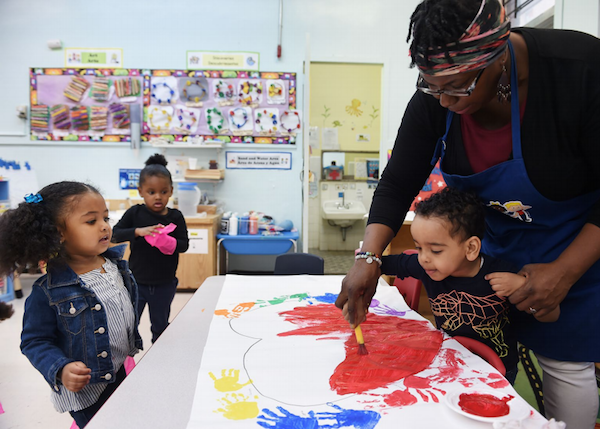
Child care (photo: Comptroller's Office)
Nearly one year into COVID-19, New York is the epicenter of an unparalleled child care crisis. Women have left the workforce in record numbers as the burden of holding together families falls disproportionately on them, child care options dry up and remote schooling remains our children’s new normal for the foreseeable future. Unsurprisingly, women of color are bearing the brunt of the job losses, with Black women and Latinas experiencing the highest rates of unemployment nationwide. At the same time, child care programs – mostly women-run – are struggling to hold on under the financial strain of pandemic-related expenses and declining revenues.
But make no mistake – this crisis is one of our own making. For decades, government has failed to invest in child care as a public good, leaving families with a patchwork of unaffordable options of varying quality and providers, especially those in our underfunded subsidized system, with poverty wages and no resources to weather this emergency. As the pandemic descended on the city, these fault lines only deepened and reinforced gender and racial disparities in the workforce and at home.
Long before the pandemic, we proposed building out a comprehensive infant and toddler care system, NYC Under 3, to build upon the city’s existing pre-kindergarten infrastructure and provide high-quality, affordable child care to New York City children aged zero to three. Through a small child care tax on the top 5% of the city’s biggest employers, we could begin charting a path to universal access – expanding care to tens of thousands of low- and moderate-income families currently shut out of support, raising wages of the care workforce, and eliminating child care deserts across the city.
But now we need to focus on the emergency at hand and recognize that there will be no economic recovery – not for women, and especially not for women of color – without child care.
The good news: the federal government can rescue the child care sector. New York State is slated to receive $450 million in emergency child care funds through the Consolidated Appropriations Act that Congress passed at the end of December. The Biden-Harris Administration has earmarked another $40 billion for child care in their American Rescue Plan. If Congress approves close to this amount, New York would likely see another $1 billion in child care funding.
The bad news: New York previously received more than $160 million in CARES Act funds to stabilize the child care sector, and the allocation of those dollars has been complicated by delays and red tape – preventing dollars from quickly getting into the pockets of the providers most in need of support and hurting the options available to families.
New York State must submit a plan this month for how it will spend the emergency funds. It is critical that these new resources are distributed to families and providers efficiently and strategically. The State should look to the proposal outlined by the Empire State Campaign for Child Care, which recommended directing a share of funds to shore up the existing subsidy system, which primarily serves lower-income New Yorkers, and getting low-barrier stabilization grants directly to providers to make up for lost revenue over the last year.
Even before the pandemic, there was only enough capacity to serve one in five infants citywide. It is critical that we invest now to ensure financially-strapped programs aren’t forced to close their doors permanently – and families aren’t left with even fewer options.
Parents and child care providers must also have a seat at the table in deciding how resources are spent. This is not just good governance; having those closest to these challenges participating in decision-making processes makes for better policy.
Even if we get this next step right, covid relief is not a long-term solution to our child care crisis. The State and City must step up and do what is needed to actually expand access to quality, affordable child care. Additional state and local investments are particularly important to ensure families whose immigration status makes them ineligible for federal relief are not excluded.
With federal resources on the way and the next State and City budgets under negotiation, we have the chance to build a strong foundation upon which we can work toward the day when high-quality, affordable child care is available to all.
***
Scott M. Stringer is the New York City Comptroller. State Senator Jessica Ramos represents parts of Queens. On Twitter @scottmstringer & @jessicaramos.
***
Have an op-ed idea or submission for Gotham Gazette? Email This email address is being protected from spambots. You need JavaScript enabled to view it.